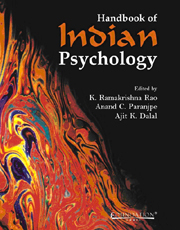Book contents
- Frontmatter
- Contents
- Contributing Authors
- Preface
- 01 Prologue: Introducing Indian Psychology
- 02 Indian Thought and Tradition: A Psychohistorical Perspective
- PART I SYSTEMS AND SCHOOLS
- 03 Jaina Psychology
- 04 The Foundations of Early Buddhist Psychology
- 05 Varieties of Cognition in Early Buddhism
- 06 A Buddhist Theory of Unconscious Mind (Ālaya-Vijñāna)
- 07 Indian Buddhist Theories of Persons
- 08 Buddhist Psychology: A Western Interpretation
- 09 Transpersonal Psychology in the Bhagavad-Gītā: Reflections on Consciousness, Meditation, Work and Love
- 10 Yoga Psychology: Theory and Application
- 11 Patañjali Yoga and Siddhis: Their Relevance to Parapsychological Theory and Research
- 12 Yoga Psychology and the, Sāṃkhyā Metaphysic
- 13 Psychology in the Advaita Vedānta
- 14 The Nyāya-Vaiśeṣika Theory of Perceiving the World of our Experience
- 15 Psychological Theories and Practices in Āyurveda
- PART II TOPICS AND THEMES
- PART III APPLICATIONS AND IMPLICATIONS
- Pronunciation and Transliteration of Sanskrit Alphabet
- Glossary
- Index
14 - The Nyāya-Vaiśeṣika Theory of Perceiving the World of our Experience
from PART I - SYSTEMS AND SCHOOLS
Published online by Cambridge University Press: 26 October 2011
- Frontmatter
- Contents
- Contributing Authors
- Preface
- 01 Prologue: Introducing Indian Psychology
- 02 Indian Thought and Tradition: A Psychohistorical Perspective
- PART I SYSTEMS AND SCHOOLS
- 03 Jaina Psychology
- 04 The Foundations of Early Buddhist Psychology
- 05 Varieties of Cognition in Early Buddhism
- 06 A Buddhist Theory of Unconscious Mind (Ālaya-Vijñāna)
- 07 Indian Buddhist Theories of Persons
- 08 Buddhist Psychology: A Western Interpretation
- 09 Transpersonal Psychology in the Bhagavad-Gītā: Reflections on Consciousness, Meditation, Work and Love
- 10 Yoga Psychology: Theory and Application
- 11 Patañjali Yoga and Siddhis: Their Relevance to Parapsychological Theory and Research
- 12 Yoga Psychology and the, Sāṃkhyā Metaphysic
- 13 Psychology in the Advaita Vedānta
- 14 The Nyāya-Vaiśeṣika Theory of Perceiving the World of our Experience
- 15 Psychological Theories and Practices in Āyurveda
- PART II TOPICS AND THEMES
- PART III APPLICATIONS AND IMPLICATIONS
- Pronunciation and Transliteration of Sanskrit Alphabet
- Glossary
- Index
Summary
The Nyāya system and the Vaiśeṣika system of Indian Philosophy were two independent systems in the beginning i.e., during the second and third century bce; but in course of time, by the tenth century ce, they merged into one system, popularly known as Nyāya-Vaiśeṣika system of Indian Philosophy.
The basic text of the Nyāya system is the Nyāyasūtra of Akṣapāda Gautama on which Vātsyāyana wrote his elaborate commentary called Bhāṣya which was commented upon by Udyotakara. His commentary is called Vārttika. This Vārttika was commented upon by Vācaspati Miśra. His commentary is known by the name Tātparya on which Udayanācārya wrote a commentary called Pariśuddhi. From Vātsyāyana to Udayanācārya the development of the Nyāya system has been in the form of a dialogue. It was mainly the Buddhists who kept on asking questions on each commentary and the next commentary was the answer to those objections. This added depth to the structure of Indian philosophical thoughts. That is why, this period of over one thousand years is called the golden period in the intellectual history of India. This entire development had taken place in the eastern part of India called Mithila at that time. This phase of development of Nyāya system is called Prācina Nyāya or Old system of logic and epistemology. Thereafter begins the development of the next phase of Nyāya system called Navya Nyāya or Neo-logic and epistemology. While the Prācīna Nyāya concentrated on the fundamental philosophical issues, the Navya Nyāya kept on developing ambiguity-free medium of discourse to deal with basic epistemological issues.
- Type
- Chapter
- Information
- Handbook of Indian Psychology , pp. 286 - 298Publisher: Foundation BooksPrint publication year: 2008

